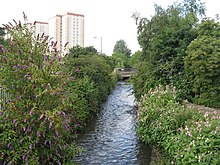
Back لوثيان Arabic Лотыян Byelorussian Lothian Breton Lothian Czech Lothian Welsh Lothian (Schottland) German Lothian Esperanto Lothian Spanish Lothian Finnish Lothian French
55°54′33″N 3°05′04″W / 55.90917°N 3.08444°W
Lothian | |
|---|---|
 | |
| Country | Scotland |
| Area | |
| • Total | 1,720 km2 (666 sq mi) |
| Population (2014)[1] | |
| • Total | 858,090 |
| • Density | 497/km2 (1,288/sq mi) |


Lothian (/ˈloʊðiən/; Scots: Lowden, Loudan, -en, -o(u)n;[2] Scottish Gaelic: Lodainn [ˈl̪ˠot̪aɲ]) is a region of the Scottish Lowlands, lying between the southern shore of the Firth of Forth and the Lammermuir Hills and the Moorfoot Hills. The principal settlement is the Scottish capital, Edinburgh, while other significant towns include Livingston, Linlithgow, Bathgate, Queensferry, Dalkeith, Bonnyrigg, Penicuik, Musselburgh, Prestonpans, Tranent, North Berwick, Dunbar, Whitburn and Haddington.
Historically, the term Lothian referred to a province encompassing most of what is now southeastern Scotland. In the 7th century it came under the control of the Anglian kingdom of Bernicia, the northern part of the later kingdom of Northumbria, but the Angles' grip on Lothian was quickly weakened following the Battle of Nechtansmere in which they were defeated by the Picts. Lothian was annexed to the Kingdom of Scotland around the 10th century.[3]
Subsequent Scottish history saw the region subdivided into three counties—Midlothian, East Lothian, and West Lothian—leading to the popular designation of "the Lothians".
- ^ "Estimated population by sex, single year of age and administrative area, mid-2014" (PDF). National Records of Scotland. Retrieved 17 May 2015.
- ^ "Dictionary of the Scots Language :: SND :: Lowden prop. n". Dsl.ac.uk. Retrieved 26 May 2016.
- ^ "Ancient Lothian Timeline". Cyberscotia.net. Archived from the original on 21 August 2010. Retrieved 19 August 2009.
© MMXXIII Rich X Search. We shall prevail. All rights reserved. Rich X Search